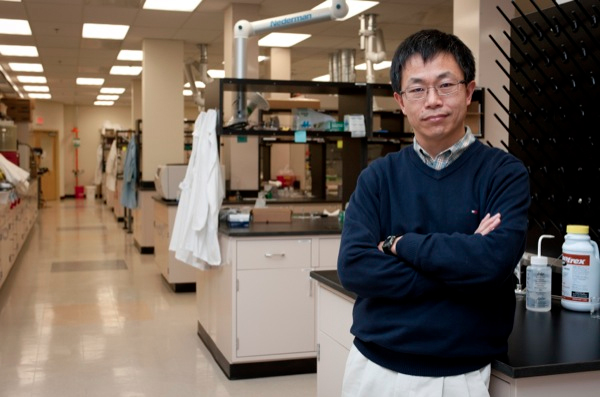Researcher discovers inexpensive catalyst to produce oxygen and hydrogen gas
10:16 a.m., May 29, 2014–The University of Delaware’s Yushan Yan believes that electrochemical energy engineering is the key to reducing humankind’s reliance on combustion as the dominant player in energy conversion.
All of his research is aimed at laying the foundation for a new era of affordable electrochemical devices, including fuel cells, electrolyzers, solar hydrogen generators, and redox flow batteries.
“Fuel cells coupled with solar hydrogen generators and/or water electrolyzers can provide clean power for mobile and stationary uses, while redox flow batteries are ideal for large-scale solar and wind electricity storage,” says Yan, Distinguished Professor of Engineering at UD.
Creating this suite of devices is a tall order, and Yan knows that success is achieved one small breakthrough at a time. He and his research group recently made one such breakthrough when they synthesized a nickel-based catalyst that can split water into oxygen and hydrogen gas. Nickel, which is cheap and abundant, is an attractive replacement for currently used precious metals.
“Cheap and efficient oxidative water splitting is an important piece of the big picture of electrochemical energy conversion because this reaction enables the use of water as an energy source,” Yan says. “But without a catalyst, water splitting is both slow and inefficient. The most successful candidates developed for water oxidation so far have been oxides of ruthenium or iridium, which are both scarce and expensive.”
The work is reported in a paper, “Efficient Water Oxidation Using Nanostructured α‑Nickel-Hydroxide as an Electrocatalyst,” published in the Journal of the American Chemical Society (JACS) online on April 25. It was also selected for coverage in JACS Spotlights, a feature aimed at making JACS research more accessible to the broader community.
The researchers demonstrated that nickel nanostructures in the form of hollow spheres can catalyze the reaction under conditions that compare favorably to the ruthenium catalyst. Further, the nickel catalyst is much more robust after several cycles of the water-splitting reaction.
“Our approach may lead to a cheaper and more efficient way to create hydrogen to be used for cleaner energy production,” Yan says.
With minor variations, all of the electrochemical devices in Yan’s vision for a combustion-free energy share the same basic three-layer structure: electrode/membrane/electrode.
With price and abundance being critical in the selection of materials for these devices, Yan emphasizes that a major shift is needed in the state of the technology.
“We have to switch from proton exchange membranes, which are acidic, to hydroxide exchange membranes, which are basic, if we want to eliminate the use of precious metals,” he says. “Ultimately, this approach will lead to a new generation of affordable and commercially viable electrochemical systems.”
Article by Diane Kukich
Photo by Kathy F. Atkinson

